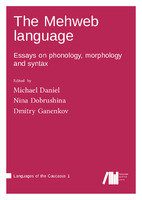The Mehweb language
Essays on phonology, morphology and syntax
| dc.contributor.editor | Daniel, Michael | |
| dc.contributor.editor | Dobrushina, Nina | |
| dc.contributor.editor | Ganenkov, Dmitry | |
| dc.date.accessioned | 2020-03-10 03:00:38 | |
| dc.date.accessioned | 2020-04-01T09:14:35Z | |
| dc.date.available | 2020-04-01T09:14:35Z | |
| dc.date.issued | 2019-10-23 | |
| dc.identifier | 1006735 | |
| dc.identifier.uri | http://library.oapen.org/handle/20.500.12657/23417 | |
| dc.description.abstract | This book is an investigation into the grammar of Mehweb (Dargwa, East Caucasian also known as Nakh-Daghestanian) based on several years of team fieldwork. Mehweb is spoken in one village community in Daghestan, Russia, with a population of some 800 people, In many ways, Mehweb is a typical East Caucasian language: it has a rich inventory of consonants; an extensive system of spatial forms in nouns and converbs and volitional forms in verbs; pervasive gender-number agreement; and ergative alignment in case marking and in gender agreement. It is also a typical language of the Dargwa branch, with symmetrical verb inflection in the imperfective and perfective paradigm and extensive use of spatial encoding for experiencers. Although Mehweb is clearly close to the northern varieties of Dargwa, it has been long isolated from the main body of Dargwa varieties by speakers of Avar and Lak. | |
| dc.language | English | |
| dc.subject.classification | thema EDItEUR::C Language and Linguistics::CF Linguistics | en_US |
| dc.subject.other | Linguistics | |
| dc.title | The Mehweb language | |
| dc.title.alternative | Essays on phonology, morphology and syntax | |
| dc.type | book | |
| oapen.identifier.doi | 10.5281/zenodo.3374730 | |
| oapen.relation.isPublishedBy | 0bad921f-3055-43b9-a9f1-ea5b2d949173 | |
| oapen.relation.isFundedBy | b818ba9d-2dd9-4fd7-a364-7f305aef7ee9 | |
| oapen.relation.isbn | 9783961102082 | |
| oapen.place.publication | Berlin | |
| oapen.grant.number | 104952 | |
| oapen.grant.program | Language Science Press 2018 - 2020 | |
| oapen.identifier.isbn | 9783961102082 | |
| grantor.number | 104952 |

